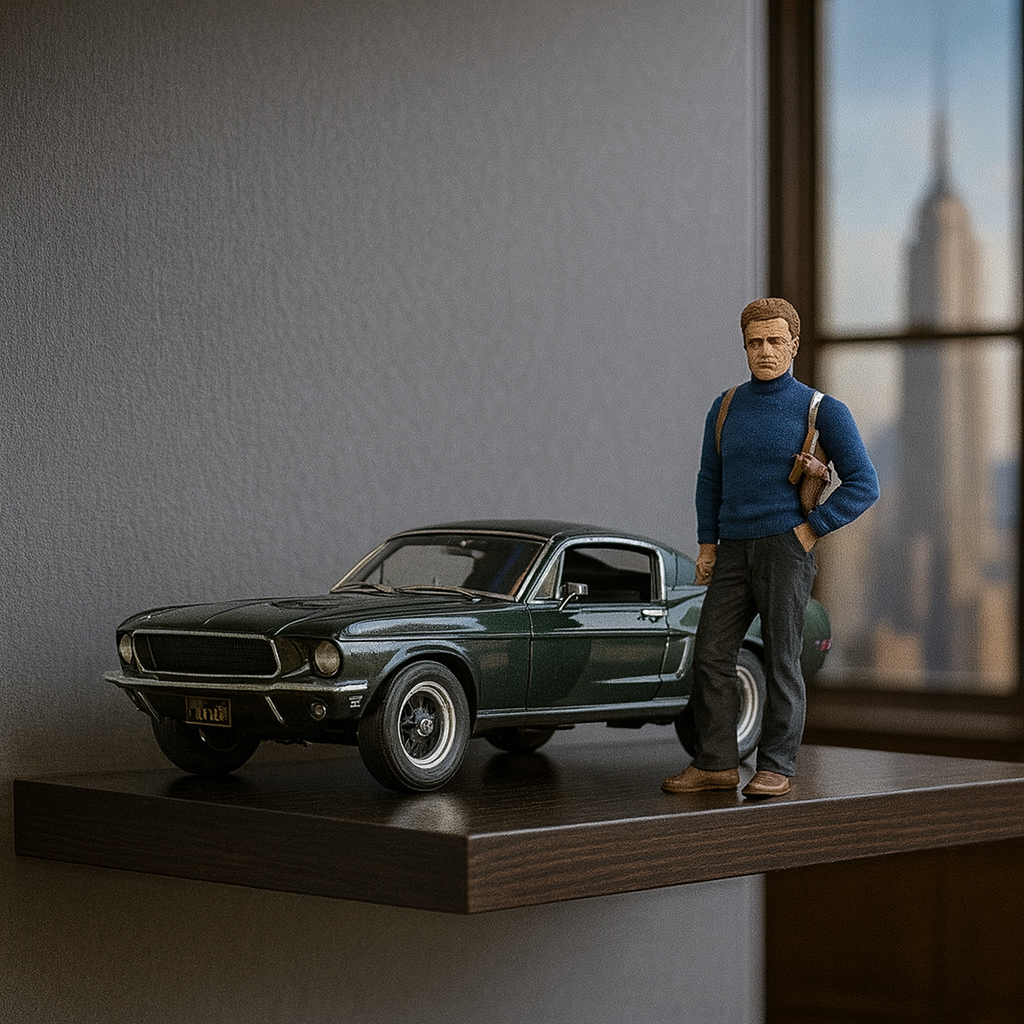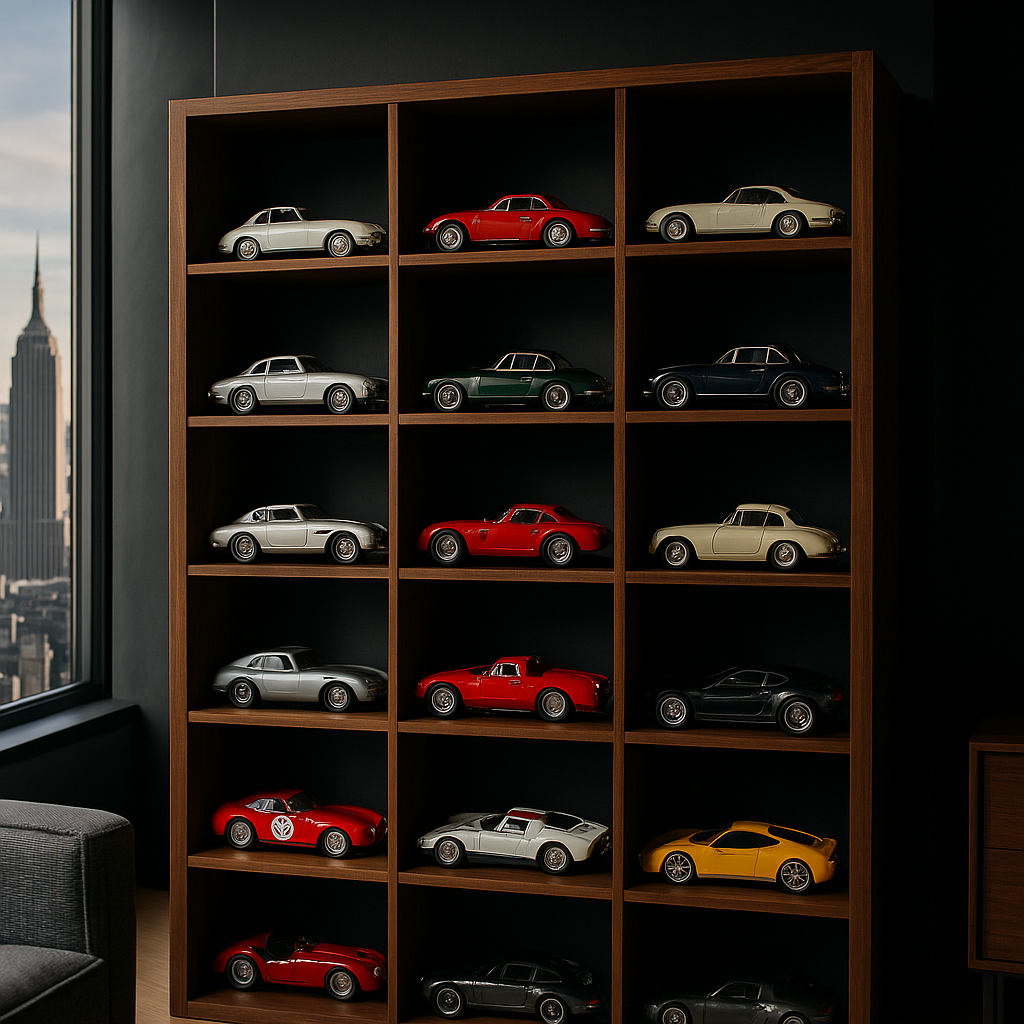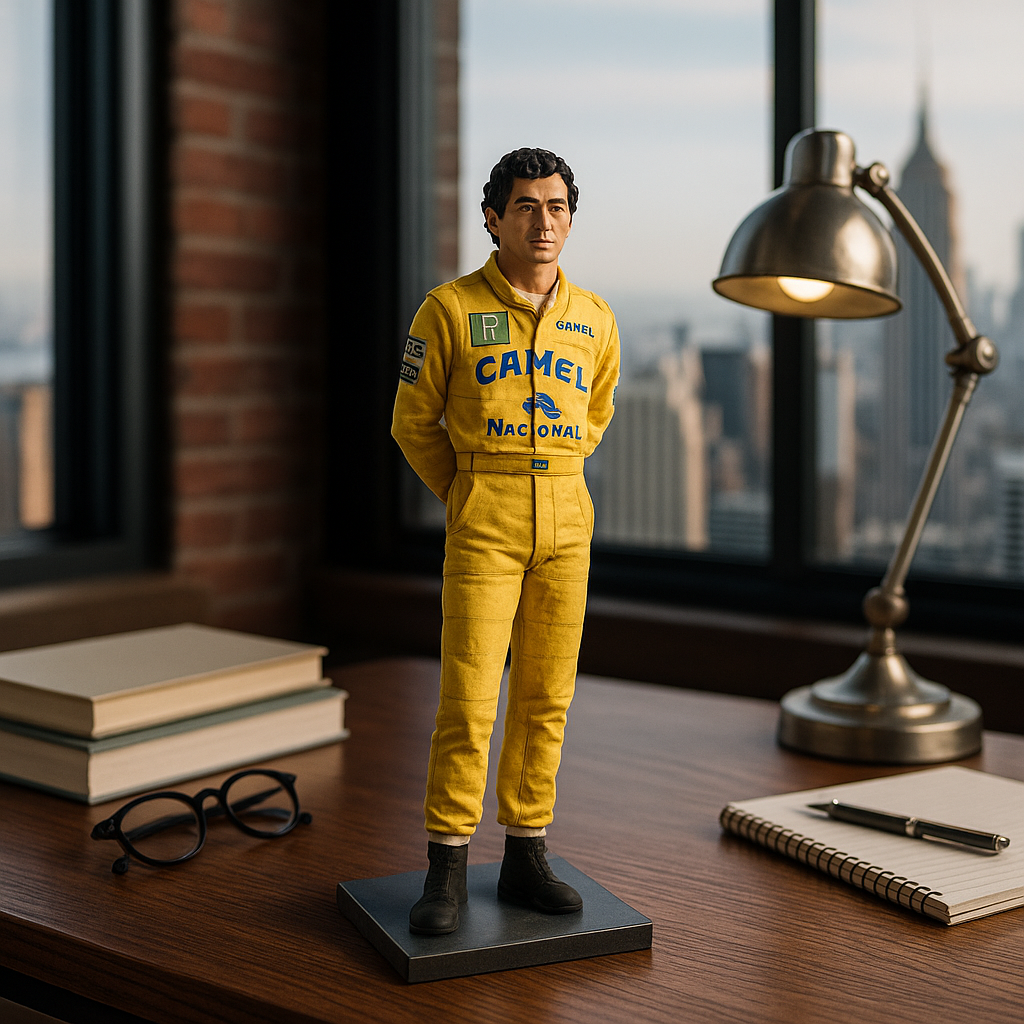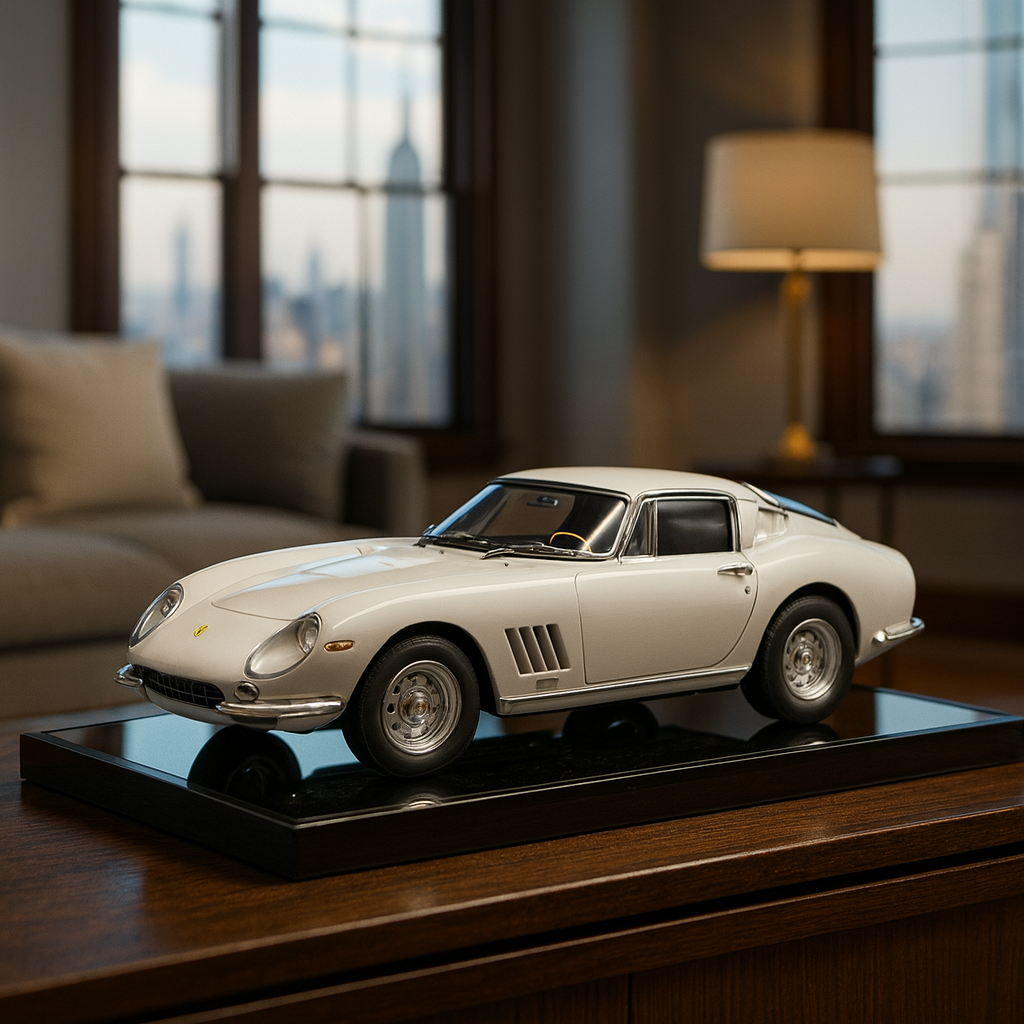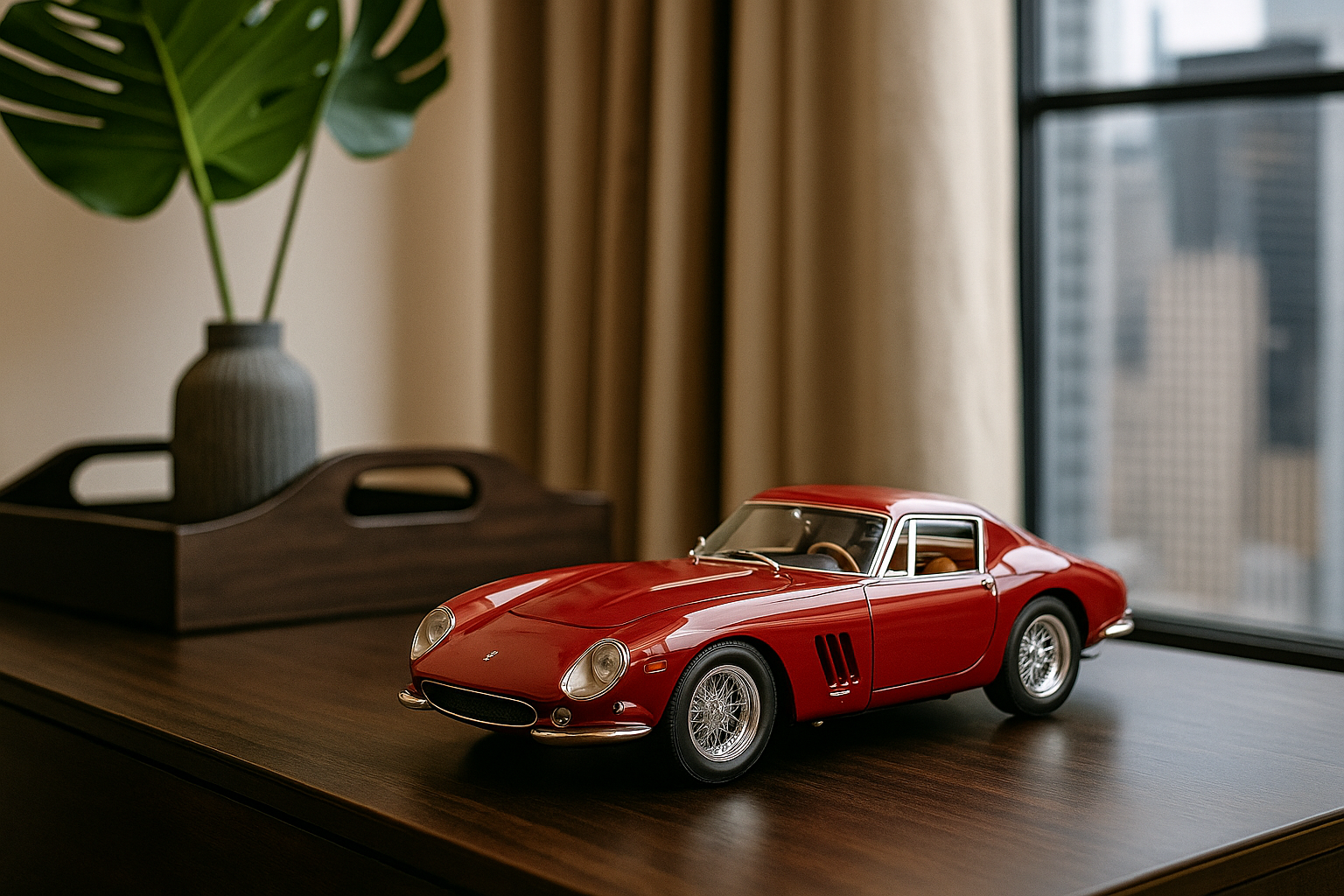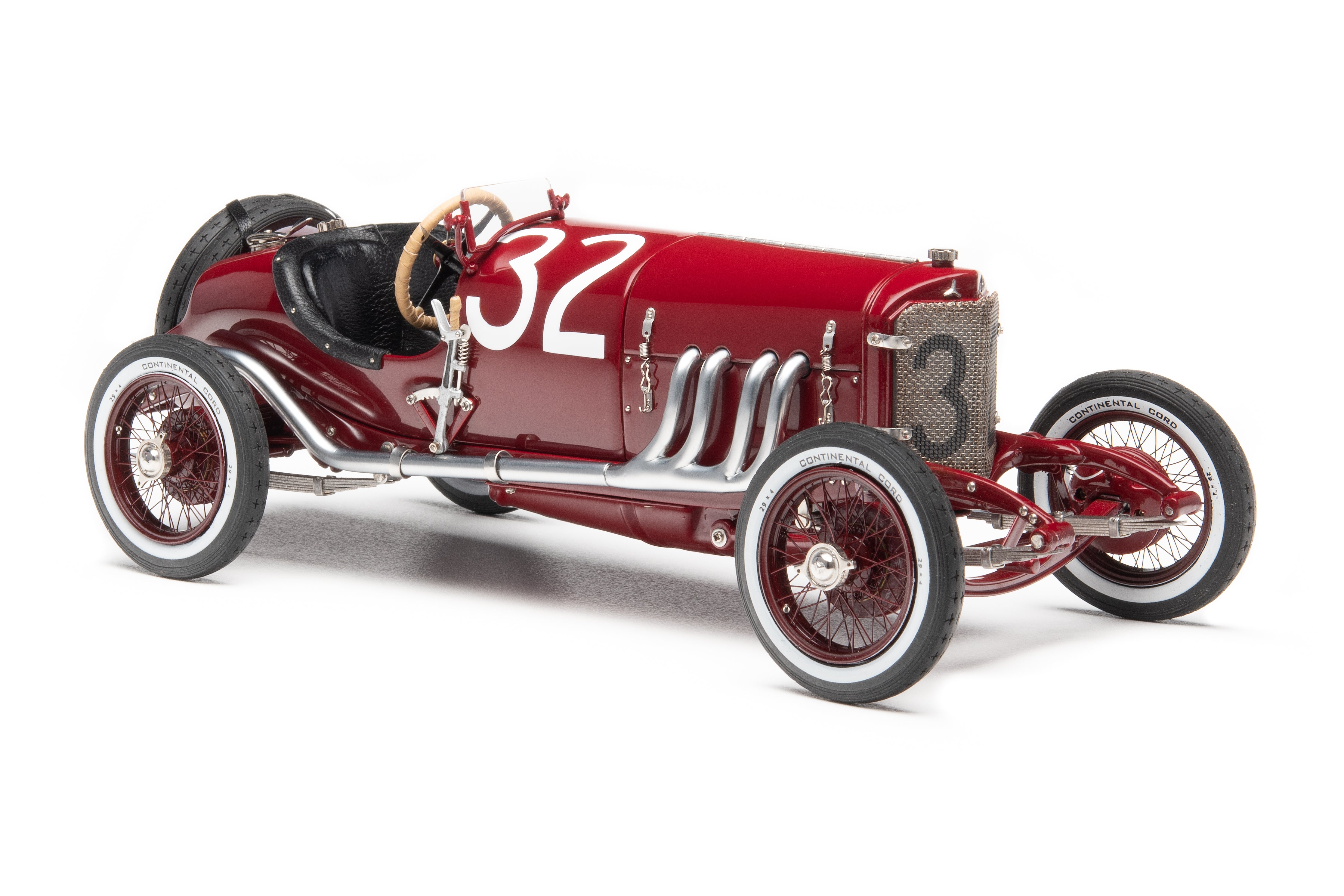
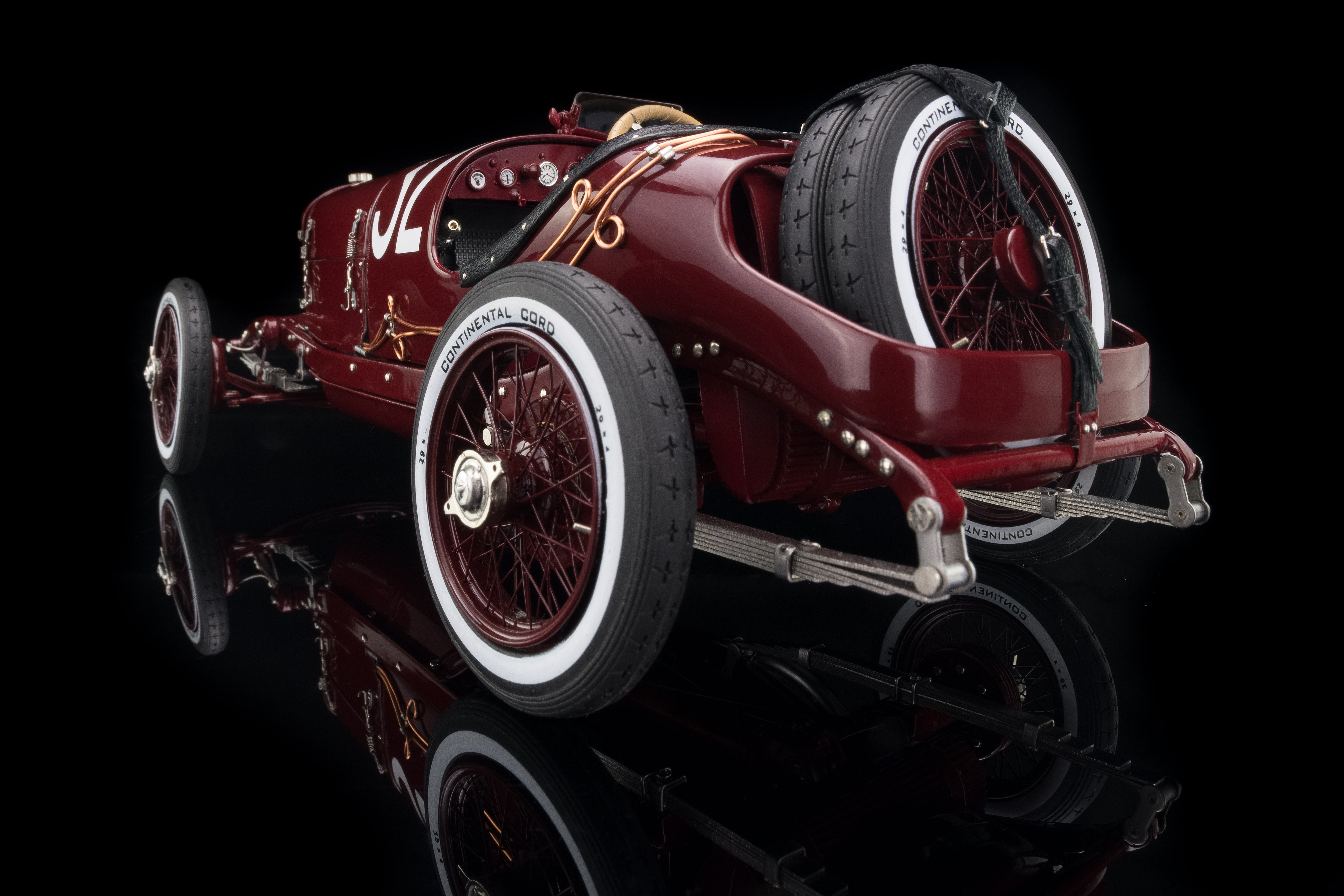

Mercedes Targa Florio 1924 Christian Lautenschlager / Wilhelm Traub CMC M-187 LE 600

Description
The model is limited to only 600 pieces.
The heyday of supercharged racing cars began in 1923. Daimler-Motoren-Gesellschaft in Stuttgart-Untertürkheim was also keen to embrace this development and designed a new vehicle.
With the preparations for the racing car for the 1924 Targa Florio, Ferdinand Porsche had made an excellent debut as the new chief designer at Daimler-Motoren-Gesellschaft. The supercharged M7294 engine from 1923 was extensively redesigned under his personal direction and ultimately featured a whole series of groundbreaking innovations. Power was increased to 126 hp (up to 150 hp by the end of 1924). The supercharger – a so-called Roots blower – is flanged to the front of the engine. When power is required, the driver activates it by firmly pressing the accelerator pedal. The resulting mechanical supercharging increases power from the normal 68 hp to the aforementioned 126 hp.
The Targa Florio and the Coppa Florio were among the toughest and most difficult road races in Europe at the time. One lap of the extremely narrow and winding mountain route of the so-called Madonie circuit, just outside Palermo in Sicily, is 108 km long. Four laps are required for the Targa Florio (432 km). The Coppa Florio requires another lap, for a total race distance of 540 km.
A grueling circuit full of dangers, also known as the route of “7000 curves”.
Whoever wins the Targa Florio is by no means necessarily the winner of the Coppa Florio, because the risk of getting into trouble on the last 5th lap is always very high.
Mercedes is sending three cars to this prestigious racing event. The Mercedes team had prepared meticulously. Three months before the race, two cars were sent to Sicily for test drives. Various rear axle ratios were tested, with the result that a top speed of 120 km/h was agreed upon.
On April 27, 1924, the time had come. Mercedes entered the race with three racing teams, with the following team pairings:
· Christian Werner with co-driver Karl Sailer, starting number 10
· Christian Lautenschlager with co-driver Wilhelm Traub, starting number 32
· Alfred Neubauer (later Mercedes-Benz racing director) with co-driver Ernst Hemminger, starting number 23
In addition to operating the oil and gasoline shut-off valves, the passengers also operated two additional hand pumps, among other things to ensure a steady buildup of pressure in the fuel tank. The passenger's assistance was also, of course, in great demand in the event of flat tires.
Unusually for German racing cars, instead of the usual white, the paint job is a vibrant red, actually the Italian racing color. This move, intended as camouflage, was intended to protect the car from the hotheaded locals, who, based on experience, often tried to impede or even throw stones at cars of a different color, and thus opposing cars.
The total starting field consisted of 37 cars with 11 German, 3 Austrian, 16 Italian and 7 French participants.
In the race itself, Christian Werner fared best in car number 10. From the second lap onward, he took the lead and held on despite fierce attacks, especially from his Alfa Romeo competitors.
He confidently won the Targa Florio in 6 hours, 32 minutes, and 37 seconds, and the Coppa Florio in 8 hours, 17 minutes. A sensational one-two for Mercedes in a new record time. Werner also set the fastest lap with a time of 1:35.
In recent years, CMC has already launched this vehicle as a hand-assembled precision model made up of over 1,000 parts.
The other two Mercedes were also able to complete the five laps, taking second and third place in the four-lap Targa Florio classification and tenth and thirteenth place in the additional five-lap Coppa Florio classification.
CMC is taking this sensational racing result from Mercedes, namely taking the first three places at the Targa Florio, as an opportunity to present a true-to-original model of the second winner, Christian Lautenschlager with starting number 32, and the third winner, Alfred Neubauer with starting number 23, as a new product.
Of the 37 cars that started, only 21 reached the finish line after four laps (Targa Florio), while an additional lap later in the Coppa Florio only 16 cars crossed the finish line.
CMC Legal Disclaimer
The use of racing team and/or driver names, symbols, starting numbers, and/or descriptions is solely for reference purposes. Unless otherwise stated, it does not imply that the CMC scale model is a product of any of these racing teams/drivers or endorsed by any of them.
Technical data of the original vehicle
Four-cylinder in-line engine M 7294
| Perfomance: | 126 hp at 4,500 rpm |
| Engine capacity: | 1,989 cc |
| Top speed: | 120 km/h |
| Wheelbase: | 2,700 mm |
| Length: | 3,800 mm |
Notice
The model is limited to only 600 pieces.
The heyday of supercharged racing cars began in 1923. Daimler-Motoren-Gesellschaft in Stuttgart-Untertürkheim was also keen to embrace this development and designed a new vehicle.
With the preparations for the racing car for the 1924 Targa Florio, Ferdinand Porsche had made an excellent debut as the new chief designer at Daimler-Motoren-Gesellschaft. The supercharged M7294 engine from 1923 was extensively redesigned under his personal direction and ultimately featured a whole series of groundbreaking innovations. Power was increased to 126 hp (up to 150 hp by the end of 1924). The supercharger – a so-called Roots blower – is flanged to the front of the engine. When power is required, the driver activates it by firmly pressing the accelerator pedal. The resulting mechanical supercharging increases power from the normal 68 hp to the aforementioned 126 hp.
The Targa Florio and the Coppa Florio were among the toughest and most difficult road races in Europe at the time. One lap of the extremely narrow and winding mountain route of the so-called Madonie circuit, just outside Palermo in Sicily, is 108 km long. Four laps are required for the Targa Florio (432 km). The Coppa Florio requires another lap, for a total race distance of 540 km.
A grueling circuit full of dangers, also known as the route of “7000 curves”.
Whoever wins the Targa Florio is by no means necessarily the winner of the Coppa Florio, because the risk of getting into trouble on the last 5th lap is always very high.
Mercedes is sending three cars to this prestigious racing event. The Mercedes team had prepared meticulously. Three months before the race, two cars were sent to Sicily for test drives. Various rear axle ratios were tested, with the result that a top speed of 120 km/h was agreed upon.
On April 27, 1924, the time had come. Mercedes entered the race with three racing teams, with the following team pairings:
· Christian Werner with co-driver Karl Sailer, starting number 10
· Christian Lautenschlager with co-driver Wilhelm Traub, starting number 32
· Alfred Neubauer (later Mercedes-Benz racing director) with co-driver Ernst Hemminger, starting number 23
In addition to operating the oil and gasoline shut-off valves, the passengers also operated two additional hand pumps, among other things to ensure a steady buildup of pressure in the fuel tank. The passenger's assistance was also, of course, in great demand in the event of flat tires.
Unusually for German racing cars, instead of the usual white, the paint job is a vibrant red, actually the Italian racing color. This move, intended as camouflage, was intended to protect the car from the hotheaded locals, who, based on experience, often tried to impede or even throw stones at cars of a different color, and thus opposing cars.
The total starting field consisted of 37 cars with 11 German, 3 Austrian, 16 Italian and 7 French participants.
In the race itself, Christian Werner fared best in car number 10. From the second lap onward, he took the lead and held on despite fierce attacks, especially from his Alfa Romeo competitors.
He confidently won the Targa Florio in 6 hours, 32 minutes, and 37 seconds, and the Coppa Florio in 8 hours, 17 minutes. A sensational one-two for Mercedes in a new record time. Werner also set the fastest lap with a time of 1:35.
In recent years, CMC has already launched this vehicle as a hand-assembled precision model made up of over 1,000 parts.
The other two Mercedes were also able to complete the five laps, taking second and third place in the four-lap Targa Florio classification and tenth and thirteenth place in the additional five-lap Coppa Florio classification.
CMC is taking this sensational racing result from Mercedes, namely taking the first three places at the Targa Florio, as an opportunity to present a true-to-original model of the second winner, Christian Lautenschlager with starting number 32, and the third winner, Alfred Neubauer with starting number 23, as a new product.
Of the 37 cars that started, only 21 reached the finish line after four laps (Targa Florio), while an additional lap later in the Coppa Florio only 16 cars crossed the finish line.
CMC Legal Disclaimer
The use of racing team and/or driver names, symbols, starting numbers, and/or descriptions is solely for reference purposes. Unless otherwise stated, it does not imply that the CMC scale model is a product of any of these racing teams/drivers or endorsed by any of them.
Technical data of the original vehicle
Four-cylinder in-line engine M 7294
| Perfomance: | 126 hp at 4,500 rpm |
| Engine capacity: | 1,989 cc |
| Top speed: | 120 km/h |
| Wheelbase: | 2,700 mm |
| Length: | 3,800 mm |


